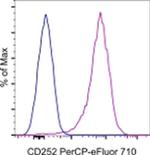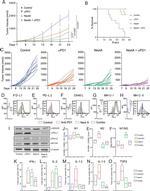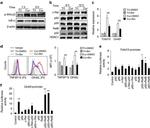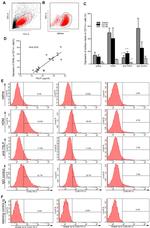Search Thermo Fisher Scientific
Invitrogen
CD252 (OX40 Ligand) Monoclonal Antibody (RM134L), PerCP-eFluor™ 710, eBioscience™
FIGURE: 1 / 7
CD252 (OX40 Ligand) Antibody (46-5905-82) in Flow







Product Details
46-5905-82
Species Reactivity
Published species
Host/Isotype
Recommended Isotype Control
Class
Type
Clone
Conjugate
Excitation/Emission Max
Form
Concentration
Purification
Storage buffer
Contains
Storage conditions
Shipping conditions
RRID
Product Specific Information
Description: The RM134L monoclonal antibody reacts with mouse CD252 also known as OX-40 Ligand, a member of the TNF superfamily. OX-40L is induced on mouse splenic B cells stimulated with a combination of anti-IgM and anti-CD40. Neither resting nor activated mouse T cells express OX-40L. The interaction of OX-40 (CD134) with OX-40L has been implicated in T cell-dependent humoral response. RM134L inhibits the costimulatory activity of mouse OX-40L transfected cells for anti-CD3-stimulated T cell proliferation.
Applications Reported: This RM134L antibody has been reported for use in flow cytometric analysis.
Applications Tested: This RM134L antibody has been tested by flow cytometric analysis of stimulated mouse splenocytes. This can be used at less than or equal to 0.25 µg per test. A test is defined as the amount (µg) of antibody that will stain a cell sample in a final volume of 100 µL. Cell number should be determined empirically but can range from 10^5 to 10^8 cells/test. It is recommended that the antibody be carefully titrated for optimal performance in the assay of interest.
PerCP-eFluor® 710 emits at 710 nm and is excited with the blue laser (488 nm); it can be used in place of PerCP-Cyanine5.5. We recommend using a 710/50 bandpass filter, however, the 695/40 bandpass filter is an acceptable alternative. Please make sure that your instrument is capable of detecting this fluorochrome.
Light sensitivity: This tandem dye is sensitive to photo-induced oxidation. Please protect this vial and stained samples from light.
Fixation: Samples can be stored in IC Fixation Buffer (Product # 00-8222) (100 µL of cell sample + 100 µL of IC Fixation Buffer) or 1-step Fix/Lyse Solution (Product # 00-5333) for up to 3 days in the dark at 4°C with minimal impact on brightness and FRET efficiency/compensation. Some generalizations regarding fluorophore performance after fixation can be made, but clone specific performance should be determined empirically.
Excitation: 488 nm; Emission: 710 nm; Laser: Blue Laser.
Filtration: 0.2 µm post-manufacturing filtered.
Target Information
The tumor necrosis factor superfamily member TNFSF4 is a type II membrane bound, non-covalently linked homotrimeric protein. It is expressed on antigen presenting cells, such as dendritic cells and activated B-cells, and also on other cells such as vascular endothelial cells, mast cells, and natural killer cells. TNFSF4 signals specifically through the TNFRSF4 receptor, is expressed predominantly on CD4+T cells but also on certain activated CD8+T cells. TNFRSF4/TNFSF4 functions as a costimulatory signal, which is required for a productive interaction between antigen presenting cells and their target T-cells. It enhances cell proliferation and survival, and increases expression of RANTES, IL-2, IL-3, and IFNgamma. TNFRSF4/TNFSF4 signaling plays an important role in immunotolerance.
For Research Use Only. Not for use in diagnostic procedures. Not for resale without express authorization.
How to use the Panel Builder
Watch the video to learn how to use the Invitrogen Flow Cytometry Panel Builder to build your next flow cytometry panel in 5 easy steps.
Bioinformatics
Protein Aliases: atherosclerosis 1; CD252; OX40 ligand; OX40L; tax-transcriptionally activated glycoprotein 1 ligand; Tumor necrosis factor ligand superfamily member 4
Gene Aliases: Ath-1; Ath1; CD134L; gp34; OX-40L; Ox40l; Tnfsf4; TXGP1; Txgp1l
UniProt ID: (Mouse) P43488
Entrez Gene ID: (Mouse) 22164

Performance Guarantee
If an Invitrogen™ antibody doesn't perform as described on our website or datasheet,we'll replace the product at no cost to you, or provide you with a credit for a future purchase.*
Learn more
We're here to help
Get expert recommendations for common problems or connect directly with an on staff expert for technical assistance related to applications, equipment and general product use.
Contact tech support

